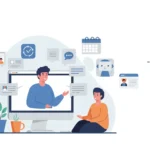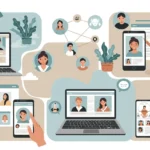Adaptive Content
Implementing adaptive content that changes based on user behavior or preferences can provide a more personalized experience. For instance, a website could display different resources or articles based on the issues or questions a visitor has interacted with previously.
User Journey Mapping
Create detailed user journey maps to understand the various paths users might take when navigating your website. This insight allows for the optimization of each touchpoint, ensuring a seamless and intuitive journey from landing page to booking an appointment.
Interactive Elements
Quizzes and Self-Assessments
Incorporate interactive quizzes or self-assessment tools that help users understand their mental health better. These tools can offer immediate value and engage users in a way that static content cannot, while also guiding them to appropriate services.
Chatbots for Immediate Assistance
Implementing a chatbot can provide users with immediate assistance, answering common questions and guiding them through the website. This instant support can significantly enhance user satisfaction and engagement.
Enhanced Booking Experience
Simplified Booking Process
Streamline the appointment booking process to reduce friction and make it as straightforward as possible. This could include a clear, step-by-step booking form, the ability to select preferred communication channels, and immediate confirmation messages.
Calendar Integration
Offering real-time calendar integration allows users to see available slots and book appointments directly through the website. This not only improves the UX but also reduces the administrative burden on therapists.
Engaging Visual and Multimedia Content
Video Introductions
Personalized video introductions from therapists can help build a connection with potential clients before they even book an appointment. Videos can convey warmth and empathy more effectively than text or images alone.
Virtual Tours
Provide virtual tours of the therapy environment to help users feel more comfortable and familiar with the space before their first visit. This can be especially reassuring for those new to therapy.
Accessibility and Inclusivity
Accessibility Features
Ensure the website is accessible to all users, including those with disabilities, by adhering to Web Content Accessibility Guidelines (WCAG). This includes text-to-speech functionality, keyboard navigation, and alternative text for images.
Inclusive Design
Design the website with inclusivity in mind, ensuring that content, imagery, and language reflect a diverse range of backgrounds and experiences. This demonstrates a commitment to providing a welcoming and supportive space for all.
Continuous Feedback Loop
User Feedback Mechanisms
Incorporate mechanisms for collecting user feedback directly on the website. This could be through short surveys, feedback forms, or suggestion boxes. Regularly reviewing and acting on this feedback is crucial for continuous UX improvement.
Conclusion
Enhancing the user experience on a therapy website requires a multifaceted approach, focusing on personalization, interactivity, ease of use, engaging content, accessibility, and inclusivity. By implementing these innovative elements and strategies, therapists can create a more welcoming, engaging, and supportive online space for their clients. As the digital world continues to change, staying attuned to the needs and preferences of your users is key to providing exceptional online therapy services. How will you enhance the user experience on your therapy website to better meet the needs of your clients?


